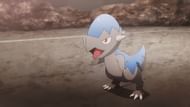The Sinnoh region introduced a fascinating milestone in Pokemon history: the first fossil Pokemon based on real dinosaurs. Before Generation IV, fossil Pokemon drew inspiration from prehistoric marine creatures or animals like ammonites, trilobites, and even pterosaurs, but not true dinosaurs.
With Cranidos and Shieldon, and their evolved forms Rampardos and Bastiodon, players finally encountered Pokemon modeled after actual prehistoric giants. These dinosaur-inspired designs added a new layer of depth and excitement to the fossil Pokemon roster.
Let’s dive into their origins, influences, and lore as well as the quirks that make these ancient Pokemon truly unique.
Note: Parts of this article are subjective and reflect the writer's opinion.
🚨 Calculate how strong your evolved Pokémon will become with our newly launched Pokemon GO Evolution Calculator 🚨
Sinnoh Fossil Pokemon: Cranidos and Rampardos

Cranidos and Rampardos are inspired by the Pachycephalosauria, a family of dinosaurs from the Late Cretaceous Period (85 to 65 million years ago). These dinosaurs are known for their thick, dome-shaped skulls, which are used in behavior that remains a topic of debate among paleontologists.
While Cranidos reflects the smaller Micropachycephalosaurus, Rampardos draws heavily from Dracorex, whose spiked skull strikingly resembles a dragon’s head.
Rampardos’ spiked head is not only intimidating but also pays homage to its supposed dinosaur counterpart. Interestingly, the current scientific consensus suggests that Dracorex may not represent a unique species but rather a juvenile form of another pachycephalosaurid.
This adds an ironic twist: if the Pokemon adhered to modern paleontology, Cranidos would likely have more spikes than Rampardos, as juvenile dinosaurs often sported more elaborate ornamentation than adults.

The Pokedex describes these Pokemon using their thick skulls to ram opponents, a claim inspired by popular depictions of pachycephalosaurs. However, scientists largely dismiss the idea that these dinosaurs engaged in head-to-head combat. Instead, evidence suggests they may have used their reinforced skulls to deliver sideways blows, akin to giraffes jousting with their necks.
Additionally, since pachycephalosaurs were herbivorous, their headbutting would have been more about competing for mates or territory than hunting prey.
Cranidos combines “cranium” (skull) and a dinosaur-sounding suffix “-dos” while Rampardos merges “ram” (to headbutt) and “rampart” (a defensive fortification), reflecting its role as an offensive powerhouse. Rampardos also held the title of the highest Attack stat among non-legendary Pokemon in its debut generation.
Also read: Exploring origin of the Kanto Fossil Pokemon
Sinnoh Fossil Pokemon: Shieldon and Bastiodon

If Rampardos epitomizes offense, Bastiodon and Shieldon embody defense. These Pokemon are modeled after ceratopsian dinosaurs, such as Triceratops and Chasmosaurus, known for their frilled skulls and defensive adaptations.
Bastiodon’s massive facial shield resembles a medieval castle wall, complete with window-like patterns that mimic defensive fortifications. Its frill-like crest aligns closely with that of Chasmosaurus, whose large, rectangular frills featured similar indentations.
Shieldon, on the other hand, draws from smaller ceratopsians like Protoceratops, an early member of the ceratopsian family. Shieldon’s compact size and lack of horns mirror the primitive traits of these early dinosaurs.

The Pokedex portrays Bastiodon as a protective Pokemon that forms impenetrable shields by lining up side by side with its kind. This aligns with its role as a defensive powerhouse in battle, boasting high Defense stats and the Sturdy ability.
The castle theming reinforces its status as a protector, with its name combining “bastion” (a stronghold) and “don” (Greek for tooth, commonly used in dinosaur names). Shieldon, similarly, merges “shield” with “don,” highlighting its defensive nature.
Bastiodon’s design might also take cues from heavy machinery, such as bulldozers and excavators. Its broad, flat face and sturdy frame evoke the functionality of construction equipment, emphasizing its defensive and immovable persona.
Also read: Exploring the origin of Hoenn Fossil Pokemon
The Sinnoh fossil Pokemon cleverly integrate real-world paleontology with the imaginative flair of the Pokemon universe. Their designs balance scientific inspiration with creative liberties, creating memorable Pokemon that resonate with fans of both paleontology and gaming.
Whether it’s Rampardos’ raw power or Bastiodon’s impenetrable defenses, these Pokemon offer a glimpse into a prehistoric world reimagined through a Pokemon lens.
While not perfectly aligned with modern paleontology, the creative interpretation adds to their charm, proving that sometimes, blending science with fantasy results in something truly timeless.
Also read: All Shiny Fossil Pokemon in Pokemon GO, ranked from worst to best
🚨 Calculate how strong your evolved Pokémon will become with our newly launched Pokemon GO Evolution Calculator 🚨
